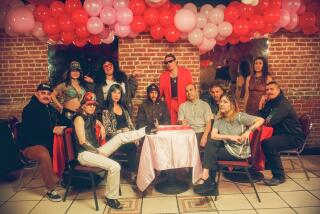Slice of Cuna Indian Life on Display in Crafts Exhibit
- Share via
Except for the Pygmies, they are the shortest people on Earth. But when it comes to colorful clothing, the Cuna Indians are second to none.
The Cunas, island dwellers off the northeast coast of Panama, make the mola, a blouse fashioned from intricate handmade panels on the front and back. The panels are topped by a yoke and sleeves of prefabricated cloth and are finished with a bottom border of the same material.
In the United States, the word mola usually refers to just the colorful panel because the entire blouse is rarely displayed in museums or sold in stores. But to the Cuna, it means the entire blouse, and an exhibit of about 40 of them will go on display Monday in the Art Gallery at Cal State Northridge.
The show includes Cuna nuchu dolls--hand-carved figures used by nelles , or shamans, to heal the sick. A few staffs, also used by nelles , are in the show.
The exhibit is part of the collection of Richard Kelton, a partner in Bollenbacher & Kelton, a Westside construction and real estate development company. Kelton acquired the pieces on a trip to the San Blas Islands in 1983.
“The Cunas have preserved their culture more intact than almost any other group of Indians in the Americas,” said Kelton, who has collected art from throughout the Pacific. “They have one of the highest rates of albinism in the world because they have preserved their ethnic purity. They’re very inbred.”
Nonetheless, icons of the developed world have found their way into Cuna crafts. The result can be quite whimsical. One mola in the CSUN exhibit depicts Mickey Mouse sitting on the moon and playing a guitar. Another is of Santa Claus, complete with holly wreaths.
“There are some great molas with the RCA Victor dog looking into a gramophone,” said Kerry Smallwood, Kelton’s daughter and curator of the CSUN show.
Most molas, however, show scenes of Cuna life, such as planting and fishing, or elements of myth. One mola depicts concentric sea turtles, one within another, that are part of the Cuna creation story. Some older molas have depicted geometric patterns, not unlike some Indian art of the Southwestern United States.
The mola panels are fashioned in reverse applique. Three or four layers of colored cloth, usually cotton, are stitched together. Top layers are cut away in successively smaller shapes to reveal the colors below. Master Cuna seamstresses add to the vividness with patches of cloth inserted between the layers, bringing the number of colors to 10 or more. Some molas are embroidered to augment the design and color.
“The molas grew out of body painting in the 1500s,” Smallwood said. “The designs were supposed to ward off evil spirits.”
Molas are worn by Cuna women and sold to exporters. The garments are small because of the Cuna’s short stature.
“A man 5 feet tall would be considered big,” Smallwood said.
The Cunas started fashioning the garments about 150 years ago, she said, when needles and cloth became available. Most of the fabric for today’s molas comes from Colombia. Sometimes the border material is polyester with vivid, clashing colors.
Kelton said he visited the San Blas Islands with Brian Dillon, a UCLA professor who specializes in Central American Indian cultures.
“As a hobby over the last 10 or 15 years, I’ve been taking archeologists, ethnologists and other scientists around the world to sites they want to visit,” said Kelton, who owns a 47-foot sailboat. “We’ve been all over the Pacific and Mediterranean.”
Dillon wanted to study Cuna burial practices.
“The Cuna have a whole city of the dead,” Kelton said. “It looks like a living community. There are homes with hammocks and sleeping quarters. The deceased are buried in a pit underneath the house. The widows and other members of the family come to this village of the dead very frequently.”
Kelton said he knew of the molas before visiting the San Blas, and he bought 250 of them at prices ranging from $20 to $300.
“But the carved wooden figures and staffs were a pleasant surprise,” he said. “Very little has been written about the Cuna’s spiritual life, so I wasn’t aware of them. There were some you couldn’t buy for any price. I wanted one of a fish and they said, no, it was still working its magic.”
However, Kelton said, the shamans were awfully quick to part with a few of the nuchu figures.
“I suspect some of them were flops,” he said.
Kelton and Smallwood will deliver a lecture on the works at 10 a.m. Monday in the gallery.
The Kelton Collection of Cuna Indian Art is in the Art Gallery, Fine Arts Building, Cal State Northridge, 18111 Nordhoff St., Monday through Oct. 13. Gallery hours are noon to 4 p.m. Mondays, 10 a.m. to 4 p.m. Tuesdays through Fridays. Free.
More to Read
Sign up for Essential California
The most important California stories and recommendations in your inbox every morning.
You may occasionally receive promotional content from the Los Angeles Times.










